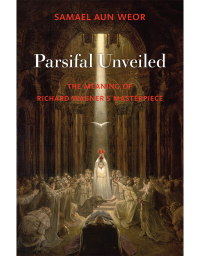“And I saw three unclean spirits like frogs come out of the mouth of the dragon, and out of the mouth of the beast, and out of the mouth of the false prophet.
“For they are the spirits of devils, working miracles, which go forth unto the kings of the earth and of the whole world, to gather them to the battle of that great day of God Almighty.” - Revelations 16:13-14
It is written with ardent fiery coals in the marvelous book of all splendors that these are the three traitors who assassinated Hiram, or better if we say Chiram-Osiris, the intimate god of every man who comes into the world.
We must search with infinite yearnings within each one of us for these three assassins of the secret master, so that, finally, on a given day (the date, day and hour does not matter), we will exclaim with all of the strength of our soul, “The King is dead, hail to the King!”
It is clear that the first treacherous one is indeed the loathsome demon of desire.
It is unquestionable that the second disloyal one is the horrifying demon of the mind.
It is evident, clear, and definitive that the third traitor is the vile demon of evil will.
Judas is the first. He is the one who sells the secret Christ for thirty silver coins.
Pilate is the second. He always washes his hands and declares himself innocent; he never recognizes himself as guilty.
Caiaphas is the third. He never does the will of the Father; he abhorred the Lord and still is abhorring Him.
The origin of these three evil ones is indeed extremely tenebrous. It is indubitable that they are an outcome of the frightful perversion of the three gunas.
Sattva is the guna of universal harmony.
Rajas is the guna of emotion.
Tamas is the guna of inertia.
Any illuminated hierophant who studies the akashic records of Nature will verify for herself the transcendental fact of the absolute equilibrium of the three gunas of mystery during the profound night of the great pralaya.
When these three gunas become unbalanced on the plates of the cosmic scale, then the dawn of the new day begins.
Krishna, that renowned master who accomplished in aforetime a gigantic mission in the sacred land of the Vedas, when emphatically referring to the three Gunas of ancient wisdom, stated in The Bhagavad Gita:
“When a soul departeth, fixed in sattva, it goeth to the sphere — perfect and pure — of those devotees who worship the most excellent.”
“If it departeth in set habitude of rajas, it shall pass into the world of people tied to action; and, if it dies in hardened tamas, that blinded soul is born anew in some unlighted womb among irrational beings.”
“Those of sattva temperament rise ever higher” to the superior spheres of the universe.
“Those of rajas take a mid place,” they are reborn in a new human body immediately or medially, without giving themselves the luxury of some vacations in the ineffable regions.
“The darkened souls of tamas sink back to lower deeps, loaded with witlessness!” They submerge themselves into the interior of the earth; they enter into the submerged mineral kingdom in order to retrograde by devolving in time; they descend through the animal, plant, and mineral steps. Afterwards, they reemerge in the Sun’s light in order to restart a new type of evolving ascent, which has to recommence in the hard rock.
Thus, the glorious lord took the floor again in order to state the following:
“When the lamp of knowledge shines through all the (nine) gates of the body, then it should be known that sattva is predominant.”
“Where longing is, and ardor, and unrest, impulse to strive and gain, and avarice, those spring from rajas — oh, Bharata! — engrained.”
“And where darkness and dullness, sloth and stupor are, ‘tis tamas hath caused them, oh Kounteya!”
“The soul, thus passing forth from the three gunas whereby arise all bodies, overcomes birth, death, sorrow, and age; becomes immortal, and drinketh deep the undying wine of Amrit.” - Bhagavad Gita 14
Kundalini Yoga teaches in a brilliant way that the Bhujangini or serpentine power is found coiled three and a half times inside the coccygeal chakra. The three coils represent the three gunas of Prakriti: sattva, rajas, and tamas. It is an axiom of the occult wisdom that the remaining half tail represents vikritis, the modification of Prakriti, the eternal feminine.
The gospel of the Lord Buddha states:
“The three daughters of Mara [the three perverted gunas] tempted the Bodhisattva, but he paid no attention to them, and when Mara saw that he could kindle no desire in the heart of the victorious Shramana, he ordered all the evil spirits at his command to attack him and overawe the great muni [holy one].”
“But the blessed one watched them as one would watch the harmless games of children. All the fierce hatred of the evil spirits was of no avail. The flames of hell became wholesome breezes of perfume, and the angry thunderbolts were changed into lotus-blossoms.”
“When Mara [the dragon of darkness] saw this, he fled away with his army from the bodhi tree, whilst from above a rain of heavenly flowers fell, and voices of good spirits were heard:”
“Behold the great muni, his heart unmoved by hatred. The wicked Mara’s host [the red devils who constitute the famous “I’”] did not prevail against him. Pure is he and wise, loving and full of mercy.”
“As the rays of the sun drown the darkness of the world, so he who perseveres in his search will find the truth, and the truth will enlighten him.”
The former verses were some among the sacred gospel of our Lord Buddha.
Many centuries after, the divine Rabbi of Galilee exclaimed with the whole strength of his soul,
“And ye shall know the truth, and the truth shall make you free.” - John 8:32
The Christian gospel states:
“God is a Spirit: and they that worship him must worship him in spirit and in truth.” - John 4:24
“Howbeit when he, the Spirit of truth, is come, he will guide you into all truth: for he shall not speak of himself; but whatsoever he shall hear, that shall he speak: and he will show you things to come.” - John 16:13
It is written with characters of ardent fire that only by dying within ourselves can we incarnate the Spirit of truth. “Whosoever knows, the word gives power to. No one has uttered it, no one will utter it, except the one who has incarnated it.”
Siddhartha, the Buddha, is the one who accomplishes what he promises to himself, as does Parsifal of the Wagnerian drama, who courageously grasps the lance of Eros in order to annihilate first the demons of Seth (the ego), and thereafter, the three furies who dwell in terrible abysses of Acheron.
Gautama was indeed a magician of Tantric initiation, who intensely practiced the Sahaja Maithuna, and who skillfully handled the lance with singular mastery.







